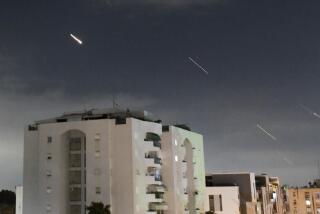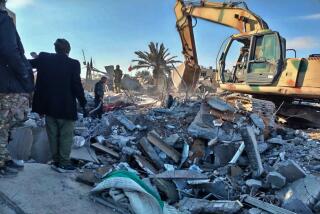Allied Forces Will Target Iraq’s ‘Center of Gravity’ : Strategy: Air strikes will continue. But if they don’t prove decisive, the stage will be set for a major air-land assault.
- Share via
Phase 2 of the air campaign is under way, said Gen. Colin L. Powell, chairman of the Joint Chiefs of Staff. One of its main targets is Saddam Hussein’s strategic reserves--the armored forces of Iraq’s elite Republican Guard. That choice of targets is most revealing, for it provides clues to what military planners believe to be the war’s center of gravity.
That center of gravity--the “hub of all power and movement, on which everything depends,” said legendary tactician Carl von Clausewitz, “the point against which all our energies should be directed”--can take several forms. Historically, however, destruction of the enemy army has been the easiest way to break his will to resist.
Certainly, the destruction of his air force and navy are also important, but that in itself is rarely decisive. Man does not live in the air or on the sea. “The final outcome,” emphasized the Navy War College in 1942, “is dependent on ability to isolate, occupy, or otherwise control the territory of the enemy, for land is the natural habitat of man.” And to do that, the enemy’s land forces must be destroyed or neutralized.
The argument within the military is not what needs to be done. The question is how to do it. All agree that air strikes are essential to soften enemy entrenchments and fortifications, disrupt his command, control and communications and scatter his reserves. But air power advocates go further and believe that bombing alone will do the trick.
As evidence, they cite the use of B-52 strategic bombers in Vietnam in a ground support role against enemy troop formations. Originally designed as a strategic nuclear bomber, the B-52s were modified to carry 51 conventional, high-explosive, 500-pound or 750-pound bombs. First used during the U.S. 1st Cavalry Division’s battle against the North Vietnamese Army (NVA) regulars at the battle of the Ia Drang in November, 1965, B-52s flew 96 sorties and poured 344 tons of bombs on NVA troop concentrations, helping to break the back of the enemy attack.
Later, U.S. air power was instrumental in lifting the North Vietnamese siege of the Marine base at Khe Sanh in 1968. A total of 2,707 B-52 sorties dropped 75,631 tons of bombs on enemy troop locations there. It was estimated that the NVA suffered 10,000 to 15,000 casualties in its unsuccessful attempt to overrun the base. A North Vietnamese prisoner of war reported that 75% of an 1,800-man regiment had been killed in a single B-52 attack.
Yet again air power proved decisive in turning back the North Vietnamese army Eastertide offensive in 1972. In that series of battles, the NVA lost an estimated 120,000 men and most of its heavy tanks and artillery, mostly to U.S. air strikes.
These were lessons of Vietnam that Saddam Hussein more than likely had not learned. But he’s learning them now, as sortie after sortie of B-52s strike the Iraqi army, moving from rear to front and from the best troops to the worst. Strikes reportedly are now concentrated against the armored divisions of the elite Iraqi Republican Guard that occupies reserve positions well to the rear, near the Iraq-Iran-Kuwait border.
As these attacks succeed, the focus probably will shift to the immediate Iraqi reserve positions in central Kuwait. Only when they have been neutralized will the air attack concentrate on Iraqi front-line troops along the Kuwait-Saudi border. Apparently, the reasoning is that with their communications and supply lines cut and their reserves destroyed, the troops manning the border defenses will break. Already they are being bombarded with propaganda leaflets urging their surrender. And soon their trenches and artillery positions will come under fire.
Thus, the air campaign will no doubt continue for some time until it either works and the enemy defenses collapse, or it becomes apparent that the enemy has weathered the storm. And if the latter is true, the stage is set for an air-land campaign to close in on the enemy and destroy him with firepower and maneuvers.
This assault will begin with an all-out air and artillery attack by allied ground forces all along the line to destroy enemy artillery positions and to eliminate their ability to maneuver. This, like the establishment of air superiority, a task which already has been accomplished, is an essential prelude to the Army and Marine ground attack.
Amphibious ships have already been moving into the northern gulf, posing the threat of a Marine amphibious landing along the eastern Kuwaiti coast. Whether the Marines land or not, the threat of such a landing effectively ties down an estimated five Iraqi divisions in coastal defense.
Meanwhile, wheeled flat-bed tank transporters are moving M1-A1 Abrams tanks and other armored equipment of the allied armies from staging areas well to the rear into attack positions near the Saudi-Kuwait border. Far enough back to be out of enemy artillery range, these attack positions prepare forces for the ground assault to come.
What form will that attack take? In military tactics, there are only three ways--frontal attack, penetration and envelopment. A frontal attack against Iraq’s fortifications is out of the question. At Cold Harbor during America’s Civil War, such an attack cost Union forces 7,000 casualties, most of them in the first eight minutes, and today’s battlefield is far more lethal than it was then.
An envelopment by fast-moving armored divisions around the enemy’s western flank would be the best form of attack, but because it is the preferred route it is almost certain that the Iraqis have planned for it and have fortified their flanks to lessen their vulnerability to such a maneuver.
Thus, a penetration attack might be necessary. That’s the way American forces broke through the West Wall along the Normandy beaches on D-Day in 1944. It is also how they later broke through Nazi Germany’s Siegfried Line. Massive bombardment by air and artillery on a very narrow portion of the enemy lines opens gaps that armored units rapidly move through and exploit well into enemy rear areas, cutting lines of supply and communication and isolating enemy front-line units from their reserves.
As the gap is widened, more allied troops pour through, effectively turning Iraq’s defenses. Entrenchments then become a liability because Iraqi troops are facing the wrong way and cannot leave their trenches, regroup and maneuver without risking destruction. They can either be mopped up or, more likely, be left to wither on the vine.
With the destruction of the Iraqi army--by massive air bombardment or through the shock action, fire and maneuver by allied land forces--the center of gravity will have been reached. That’s if all goes according to plan. But war is seldom that accommodating. A later column will examine what can go wrong.
More to Read
Sign up for Essential California
The most important California stories and recommendations in your inbox every morning.
You may occasionally receive promotional content from the Los Angeles Times.













